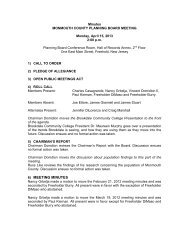NATURAL and CULTURAL FEATURES of MONMOUTH COUNTY
NATURAL and CULTURAL FEATURES of MONMOUTH COUNTY
NATURAL and CULTURAL FEATURES of MONMOUTH COUNTY
Create successful ePaper yourself
Turn your PDF publications into a flip-book with our unique Google optimized e-Paper software.
what is now the Hall <strong>of</strong> Records (Blair, 1993; MCDPI, 2005). By 1758, the Lenape (Delaware)<br />
Indians that were still living in the County were being relocated to the first Indian reservation in<br />
the US, at Indian Mills in Burlington County (Colts Neck Historical Society, 1965).<br />
In 1775, a raiding party from Portl<strong>and</strong> Point (Atlantic Highl<strong>and</strong>s <strong>and</strong> Middletown) boarded the<br />
English ship the “London” in S<strong>and</strong>y Hook Bay <strong>and</strong> threw its cargo <strong>of</strong> tea overboard to protest the<br />
closing <strong>of</strong> the port <strong>of</strong> Boston by the British following the Boston Tea Party two years earlier<br />
(Boyd, 2004). In 1777, the British massacred American troops in the County’s first engagement<br />
<strong>of</strong> the Revolutionary War at the Battle <strong>of</strong> Navesink Hills, near Hartshorne Woods <strong>and</strong> Highway<br />
36 in Highl<strong>and</strong>s (Boyd, 2004). In 1778 the Battle <strong>of</strong> Monmouth was fought in Manalapan in one<br />
<strong>of</strong> the largest battles <strong>of</strong> the American Revolution, <strong>and</strong> is memorialized at Monmouth Battlefield<br />
Park <strong>of</strong>f Rt. 33, <strong>and</strong> at “Molly Pitcher’s Well” (actually a spring) along Rt. 522 west <strong>of</strong> Freehold<br />
(MCDPI, 2005). The 12-mile long English army retreated to New York over an Indian trail in<br />
Freehold <strong>and</strong> Colts Neck that is now Dutch Lane Road. Following the ridgeline <strong>of</strong> the Mount<br />
Pleasant Hills, they marched on Kings Highway East in Middletown to cross a pontoon bridge<br />
built <strong>of</strong> anchored, planked boats over a now-closed inlet by Plum Isl<strong>and</strong> for embarkation from<br />
S<strong>and</strong>y Hook (Boyd, 2004; Colts Neck Historical Society, 1965).<br />
The first iron works in New Jersey was constructed around 1674 in Tinton Falls, Monmouth<br />
County; the industry peaked after the war <strong>of</strong> 1812 until about 1844, when transporting coal as<br />
well as richer ores <strong>of</strong> iron from Pennsylvania <strong>and</strong> other states west <strong>of</strong> NJ became more cost<br />
effective (Forman, 1998). During the Industrial Revolution <strong>of</strong> the 19 th century, the first railroads<br />
helped to develop seaside resorts such as Highl<strong>and</strong>s (Waterwitch), Long Branch, <strong>and</strong> Asbury<br />
Park, doubling the population <strong>of</strong> Monmouth, Ocean, Atlantic, <strong>and</strong> Cape May counties from<br />
55,700 in 1850 to 111,000 by 1885 (Roberts <strong>and</strong> Youmans, 1993). In 1870, the first section <strong>of</strong><br />
the Atlantic City boardwalk was opened. Steamboats brought tourists from New York to the<br />
railroad pier at Atlantic Highl<strong>and</strong>s, where they could connect with the New Jersey Southern<br />
Railroad <strong>and</strong> cross a “scissors” bridge between Highl<strong>and</strong>s <strong>and</strong> S<strong>and</strong>y Hook to towns along the<br />
way to Long Branch (the City <strong>of</strong> Keansburg ferry operated until 1968) (APP, 2006a; Gallo,<br />
2000). A 2000 foot long pier was constructed at Cedar St. in Keyport, <strong>and</strong> steamboats traveled<br />
up Matawan Creek to wharves <strong>and</strong> warehouses that had existed along Lake Lefferts as far as Rt.<br />
516 in Matawan before it silted in (Gallo, 2000; Kisk, 2006). Although most <strong>of</strong> the County that<br />
was not along the coast still remained farml<strong>and</strong>, its transition to suburbia accelerated when the<br />
majority <strong>of</strong> the 164-mile Garden State Parkway was completed by 1954, having begun<br />
construction in Union County a year after the end <strong>of</strong> World War II (NYCroads.com, 2005).<br />
OCEAN<br />
NJ bordered Morocco 245 million years ago, at the beginning <strong>of</strong> the Triassic Period, when the<br />
Appalachian <strong>and</strong> Anti-Atlas mountains that are now in Africa were a single range that may have<br />
been higher than the Himalayas (Gallagher, 2003; Wikipedia, 2009). This lasted about 75<br />
million years, until the supercontinent Pangaea began to rip apart (Gallagher, 2003). As lava<br />
formed into the basalts <strong>of</strong> the Watchung Mountains in Somerset <strong>and</strong> Passaic, <strong>and</strong> igneous<br />
intrusions cooled into the columns <strong>of</strong> the Palisades, the water surrounding Pangaea rushed in to<br />
fill the rift between the new continents, creating the Atlantic Ocean (Gallagher, 2003).<br />
Tourism

















